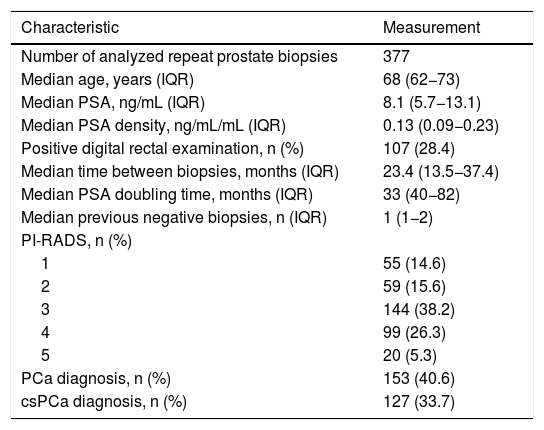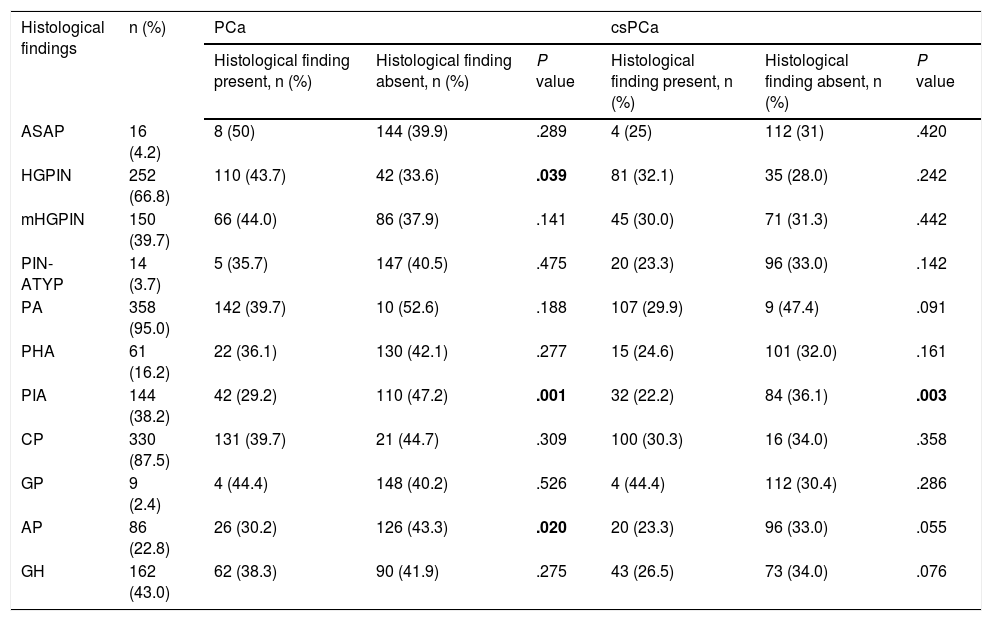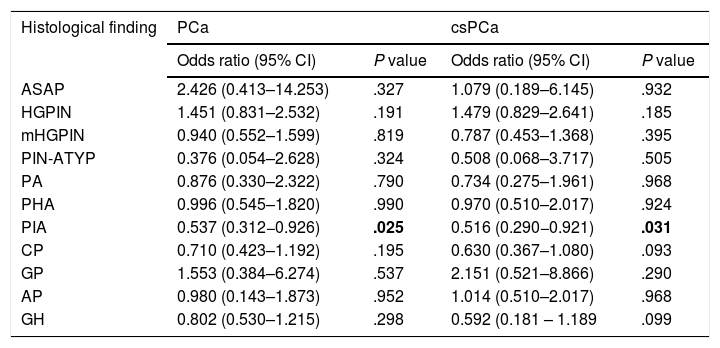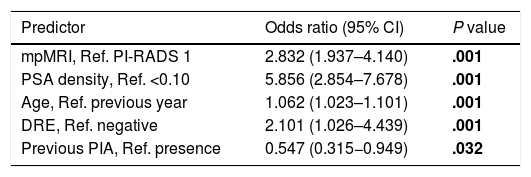Repeat prostate biopsy (PBx) is recommended under persistent suspicion of prostate cancer (PCa) or in the face of the following findings: atypical small acinar proliferation (ASAP); extense (≥3 biopsy sites) high-grade prostatic intraepithelial neoplasia (HGPIN); or HGPIN with atypical glands; suspicious for adenocarcinoma (PIN-ATYP). Nowadays; multiparametric magnetic resonance imaging (mpMRI) and mpMRI targeted PBx (MRI-TBx) are recommended in repeat PBx. Our objective was to analyze the current value of ASAP; mHGPIN; PIN-ATYP and other histological findings to predict clinically significant PCa (csPCa) risk.
MethodsRetrospective analysis of 377 repeat PBxs. MRI-TBx was performed when Prostate Imaging-Reporting and Data System (PI-RADS) score >3 and 12-core transrectal ultrasound (TRUS) systematic PBx when ≤2. ASAP; HGPIN; mHGPIN; PIN-ATYP; and 8 other histological findings were prospectively reported in negative PBx. CsPCa was defined as ISUP group grade >2.
ResultsIncidence of ASAP; multifocal HGPIN (mHGPIN) and PINATYP was 4.2%; 39.7% and 3.7% respectively; and csPCa rate was statistically similar among men with these histological findings. However; the rate of csPCa was 22.2% when proliferative inflammatory atrophy (PIA) was present; and 36.1% when it was not. PIA was the only histological finding which predicted lower risk of csPCa; with an OR of 0.54 (95%CI: 0.308−0.945; P = .031). In addition; PIA was an independent predictor of a model combining clinical variables and mpMRI which reached area under de ROC curve of 0.86 (95%CI: 0.83−0.90).
ConclusionPIA emerged as the only predictive histological finding of csPCa risk and can contribute to a predictive model. mHGPIN failed to predict csPCa risk. The low incidence of ASAP (4.2%) and PIN-ATYP (3.7%) prevented us from drawing conclusions.
Se recomienda realizar una biopsia prostática (PBx) de repetición ante una sospecha persistente de cáncer de próstata (PCa) o cuando se identifica proliferación acinar atípica (ASAP), neoplasia intraepitelial de alto grado (HGPIN) extensa (≥3 zonas de biopsia), o HGPIN con células atípicas sospechosas de adenocarcinoma (PIN-ATYP). Actualmente se recomienda realizar una resonancia magnética multiparamétrica (mpMRI) y PBx guiada por mpMRI (MRI-TBx) en una PBx de repetición. Nuestro objetivo fue analizar el valor actual para predecir el riesgo de PCa clínicamente significativo (csPCa) del hallazgo de ASAP, mHGPIN, PIN-ATYP y otros hallazgos histológicos.
MétodosSe realizó un análisis retrospectivo de 377 PBx de repetición. Se realizó MRI-TBx cuando la puntuación PI-RADS fue ≥3 y PBX sistemáticas de 12 cilindros guiadas por ecografía transrectal (TRUS) cuando fue ≤2. ASAP, HGPIN, HGPIN multifocal (mHGPIN), PIN-ATYP, y otros 8 hallazgos histológicos fueron reportados prospectivamente en las PBx negativas. El csPCa fue definido como grado ISUP ≥ 2.
ResultadosLa incidencia de ASAP, mHGPIN y PIN-ATYP fue 4.2%, 39.7% y 3.7% respectivamente, y la tasa de csPCa fue estadísticamente similar en los pacientes con estos hallazgos histológicos. Sin embargo, las tasas de csPCa con atrofia proliferativa inflamatoria (PIA) presente y ausente fueron 22.2%, y 36.1%, respectivamente. La PIA fue el único hallazgo histológico que predijo un menor riesgo de csPCa, con OR de 0.54 (IC 95%: 0.308−0.945, P = .031). La PIA fue, también, un factor predictor independiente en un modelo combinando variables clínicas y mpMRI que obtuvo un área bajo la curva de 0.86 (95% IC: 0.83−0.90).
ConclusionesLa PIA resultó ser el único hallazgo histológico predictor del riesgo de csPCa, y puede contribuir en un modelo predictivo. mHGPIN no fue predictor de riesgo de csPCa. La baja incidencia de ASAP (4.2%) y PIN-ATYP (3.7%) impidió que pudiéramos obtener conclusiones sobre estas lesiones.











